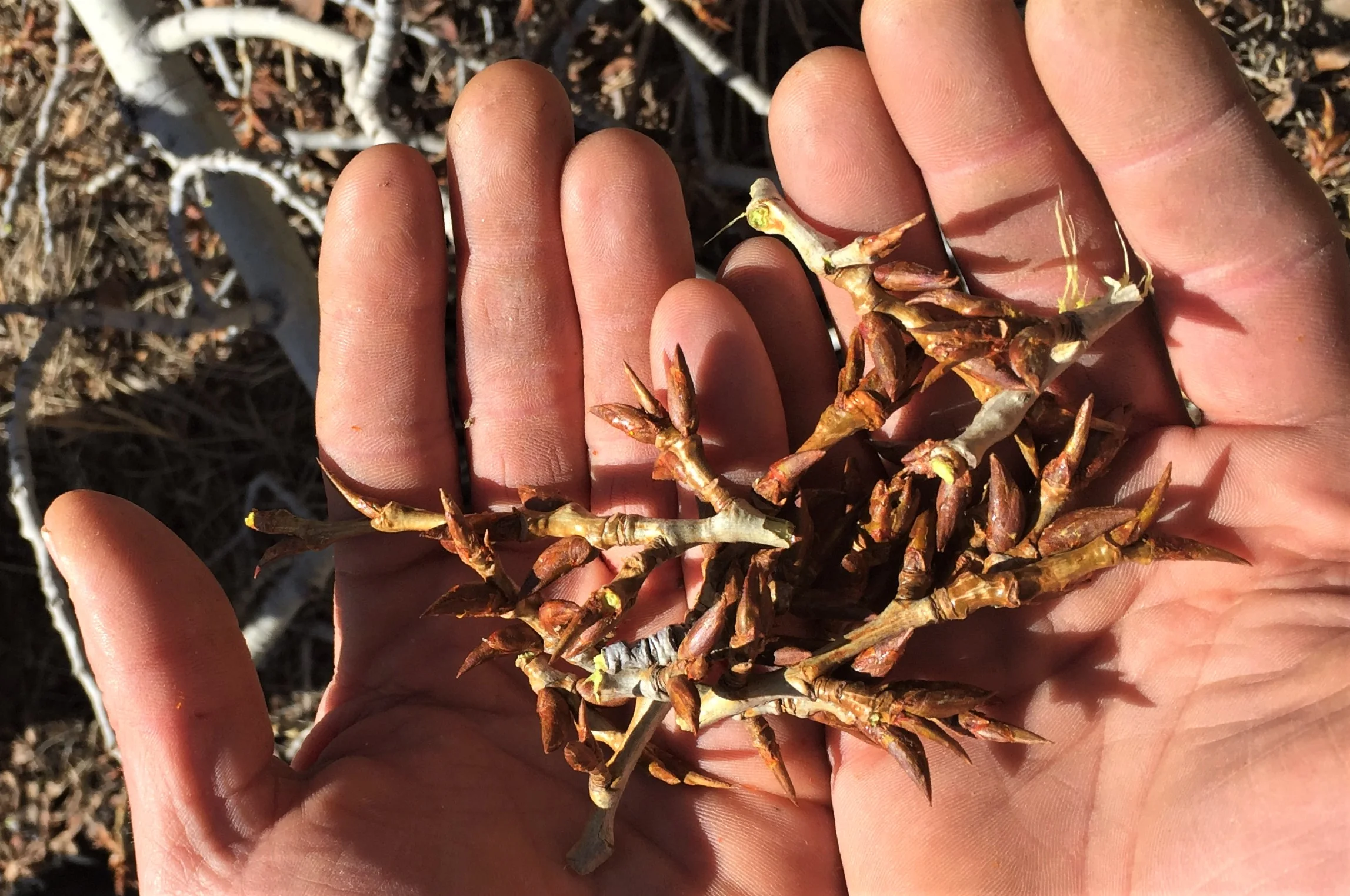Companion of the Waters
There is a group of plants called Salix. A wide-ranging and diverse group that includes nearly 400 species of deciduous trees and shrubs found all over the world. Every single one of these plants produces a powerful healing compound called salicin.
Here in the mountains of Colorado, the wild willows, quaking aspens and towering cottonwoods (Populus angustifolia) are all of the impressive Salix family.
Down on the plains of North America resides Populus deltoides, the Eastern Cottonwood. The Native Americans hold her in the highest regard. They call her Matriarch of the Plains, Queen of the Salix, bringer of the breeze, giver of shade, and companion of the water.
All of these plants are a rich source of salicin.
Long ago .. and to this very day
Salicin is the precursor to Salicylic Acid, which is the main compound in aspirin. Much like Salicylic acid, Salicin is aspirin-like with proven anti-inflammatory properties and has been part of human history for a very long time. In 400 BC, Hypocrites referenced extracts of willow bark as an effective pain reliever. The very first issue of The United States Pharmacopeia, published in 1820, mentions willow bark for these applications as well.
One of the most ancient topical applications known to us is a salve crafted in the Middle East from the buds of trees and shrubs, which produce Salicin balsam resins. Often referred to as The Balm of Gilead, these ancient remedies have a rich and diverse history. Today, Balm of Gilead is considered a catchall phrase referring to any curative salve whose interpretations are as varied as those who create it, and still to this very day stands out as a foundation of skilled herbalists’ offerings.
All the Salix plants produce Salicin, a sticky, balsamic, resinous plant compound long sought after for its anti-inflammatory and pain-relieving properties. Salicin is found in varying amounts in the leaves, bud, and bark of Salix plants, with the buds of all the cottonwood species one of the richest sources. In the spring, when the sap starts to rise after the equinox, the leaf and catkin buds begin to swell, exuding what we seek, a yellowish-orange volatile oil referred to as “balsamic resin.” This is where the Salicin is found. When extracted into an oil, liquid wax, (and honey) the bud’s resin, along with the plants and healing properties are transferred to the liquid from which we can make a salve to help protect and heal our skin, and reduce musculoskeletal pain. The honey is a powerful remedy for sore throats.
Cottonwood Bud resin also possesses a long, impressive list of additional healing compounds, including polyphenols, flavonoids, tannins, antioxidants, antifungal, and antimicrobial compounds. Tannins are astringent, meaning they draw skin tissue together, helping reduce swelling and soothe inflammatory skin conditions.
The resin is also a rich source of powerful antifungal and antimicrobial compounds, helping protect the skin from colonization by pathogenic microbes involved in itch, outbreaks, and inflammatory skin issues such as eczema and psoriasis.
(note here that there is no salicylic acid in the Salix plants. The Salicin present in the resin is converted inside the body into salicylic acid. This gives Cottonwood Bud honey some very special properties for gut health and should be part of every natural home remedy kit. A spoonful daily of infused honey makes a powerful health tonic).
See the that dripping resin? That’s what we’re after!
The narrow-leaf cottonwood, which only grows above 4,000’, seems to me to have the most medicine of all the varieties I’ve tried. Bite into one of these buds, and your tongue is instantly numb. I don’t get this from other varieties so I use these buds exclusively in my creations and I only use freshly picked buds.
Freshly picked buds are a must to create an effective infusion. Dried buds are less desirable and less potent, so I make all of my cottonwood bud-infused oil in the spring with fresh buds. Oh, the delicious aroma of cottonwood buds—spicy and balsamic, it’s heady and strong in the house when the buds are infusing.
What else can you infuse with the buds? HONEY!
Infusing buds into HONEY is the perfect remedy to soothe cough and sore throat. Cottonwood Bud Infused Honey is a household staple in our home. We use it all winter to sweeten tea and boost our immunity. It’s delicious with chai spices and ginger.
Cottonwood Bud Infused Oil & Honey .. my first projects of spring!
Collecting, processing, and preparing cottonwood bud-infused oils is a rite of spring for my husband and me!
We so enjoy our first strolls along the river banks deep in the cottonwood Bosque. It is a truly magical place and one of my favorite things to do.
Narrowleaf Cottonwood tree buds are quite small and time-consuming to collect.
I infuse a year’s worth of jojoba in the spring and use this to create salves and cleansing oils. I chose Jojoba because it’s a wax and not an oil. It is extremely stable and has a very long shelf life - up to 3 years. It doesn’t degrade when exposed to heat the way seed oils can and do - it can take some heat to create fresh infusions with “wet” plant material.
My cottonwood bud-infused Jojoba is the key ingredient in one of my FOREST FORCE PINE PITCH SALVES, a salve that helps resolve all kinds of chronic and acute inflammatory skin issues. It is as effective at helping heal eczema and scalp psoriasis as it is at reducing and preventing bruising, muscle cramps, pulled tendons, achy knees, and mild arthritis. It also soothes bug bites and itchy rashes and eases the pain of overused muscles and joints.
Follow me on my wild crafting journey .... Foraging a Frozen Land
RELEVANT PEER-REVIEWED RESEARCH:




